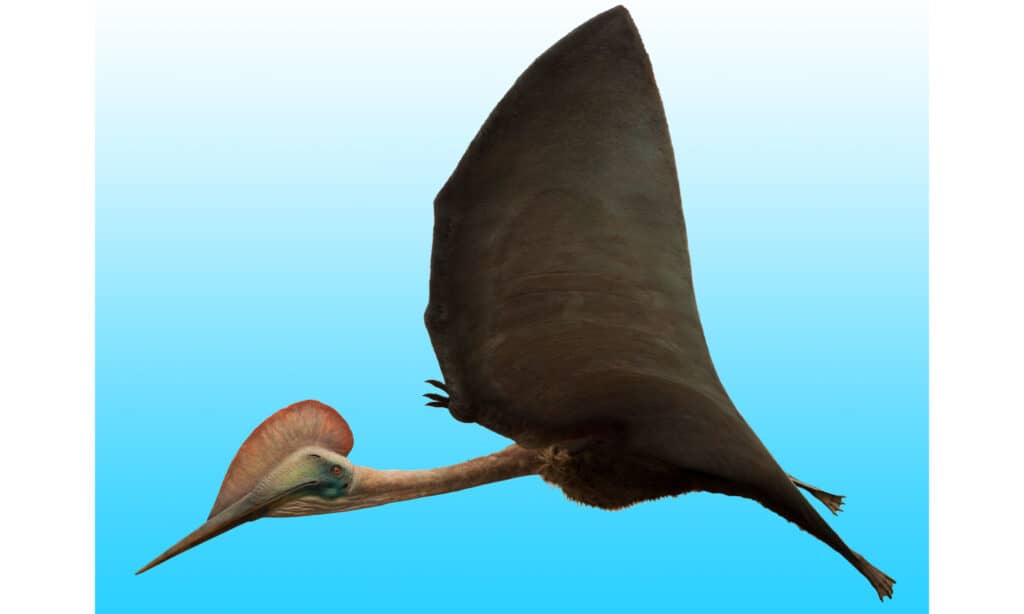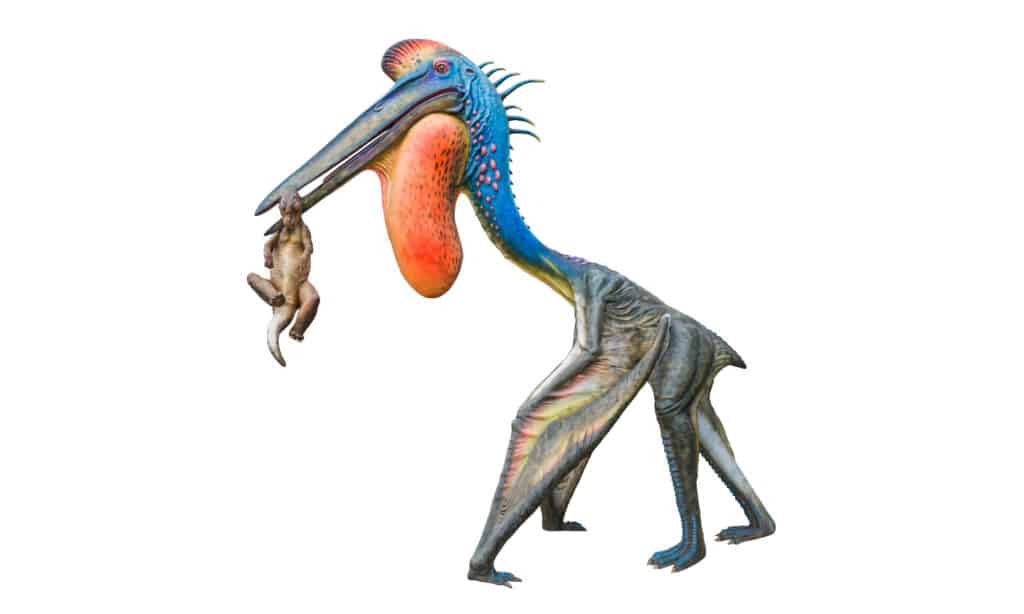Transylvania is the home of Dracula—the stuff of blood-sucking nightmares. Myth aside, the island, located in present-day Romania, was indeed ruled by a giant, flying carnivore with a particular taste for dinosaur flesh. The nine-foot-head and 36-foot-wingspan flying predator looked like the love child between a giraffe and a stork. Its name: Hatzegopteryx.
During the Late Cretaceous, Hatzegopteryx was Transylvania’s foremost predator. Hatzegopteryx grew so big that paleontologists mistook its fossils for a theropod—a group of flesh-eating dinosaurs, including the Tyrannosaurus rex. Instead, they were looking at a pterosaur (flying reptile). It wasn’t just any pterosaur, but one of the biggest pterosaurs of all time.
What Did Hatzegopteryx Look Like?

Azhdarchids like this Hatzegopteryx had long necks, legs, and beaks.
©Arctium Lappa/Shutterstock.com
Hatzegopteryx is a genus of Azhdarchid pterosaurs found during the Late Maastrichtian Stage of the Cretaceous Period. Its generic name is derived from the Hatzeg Basin of Transylvania, where the bones were discovered. The Greek word “pteryx,” means wings. However, its scientific stems from the Greek word for monster, which is just fitting for a flying beast with a nine-foot head.
Hatzegopteryx had a giant skull that measured 9.8 feet based on size comparisons with other flying reptiles from the prehistoric past. This also means it had one of the largest skulls in a non-marine animal. The skull bones of this flying predator are stout and robust, with prominent ridges that indicate strong muscular attachment. The articulation of the massive jaw bones allowed Hatzegopteryx to achieve a wide gape. Some studies suggest it had a proportionally short and deep beak.
The Hatzegopteryx fossil had a humus fragment 9.3 inches long. Scientists estimated the animal’s size by comparing the humus fragments to that of Quetzalcoatlus, which had a one-foot-9.4-inch-long humerus. Also, the estimate of the wingspan of Quetzalcoatlus was about 36 to 39 feet in 1981. Earlier estimates had exceeded this at 49 to 66 feet. However, more recent studies have confirmed a wingspan of roughly 39 feet and a weight of about 250 pounds for this flying reptile.
Hatzegopteryx had broad, short, and unusually robust neck vertebrae. The preserved portion measured 9.4 inches long, and the entire vertebra likely measured 12 inches long when it was alive. Pterosaurs had 9 neck vertebrae. The fifth vertebra, which is also the longest, measured 16 inches long. However, the same vertebra in similarly giant Arambourgiania measures eight feet 8.4 inches. This revealed that the neck of Hatzegopteryx was about 50 to 60 percent the expected size of a giant azhdarchid of its size.
Was Hatzegopteryx a Flying Predator?
Given the massive size of this reptile, one common question is whether or not they could fly since being heavy would have made flight difficult. Hatzegopteryx was not a flightless bird as one would expect for an animal with such a large skull and massive wing bones. However, if they did fly, there must have been a way for the skull’s weight to be reduced somehow.
Modern flying birds tend to have lightweight, hollow bones, which was the case with this prehistoric animal. The internal structure of the skull bones shows that it contained hollows and small pits roughly 0.4 inches long, separated by a matrix of tiny bony struts. This helped the Hatzegopteryx achieve the necessary weight reduction. The wing bones also had a similar structure. This feature would have made the structure stress-resistant, sturdy, and lightweight, allowing the Hatzegopteryx to fly.
What Did Hatzegopteryx Eat?
Hatzegopteryx was a foraging flying predator. It was a generalist, which means it ate any smaller animal it could. Since Hatzegopteryx was larger than other terrestrial predators from Maastrichtian Europe and lived in an environment dominated by dwarf dinosaurs, finding prey would have been relatively easy.
Hatzegopteryx head and neck muscles could withstand a lot of force, meaning they could stab and bludgeon fairly large dinosaurs of their time. This animal ate dinosaurs and larger prey compared to other azhdarchids.
Where Did the Hatzegopteryx Live?

This pterosaur is sometimes considered the biggest flyer ever.
©YuRi Photolife/Shutterstock.com
Hatzegopteryx lived on Hateg Island, located in the prehistoric Tethys Sea around 66 million years ago. This island corresponds to modern-day Hateg, Hunedoara County, Romania. Unlike the present day, the climate of this region back in the Cretaceous was likely subtropical, with a distinct dry and wet season.
Hatzegopteryx inhabited an island full of small dinosaurs. This flying predator lived in the environment of wetlands, rivers, alluvial plains, and woodlands dominated by ferns and angiosperms. Expectedly, it was the apex predator of its ecosystem. Without any giant beast to compete with it, it ruled the skies of its home habitat.
Discovery and Extinction
Hatzegopteryx fossils were first discovered on an island in Transylvania, western Romania, in the upper part of the Middle Densuş-Ciula Formation. The island is referred to as Hateg Island. Their existence date back to 66 million years ago, during the Late Cretaceous Period. The holotype of this dinosaur includes fragments of the left humerus and the back of the skull.
When they announced the find in 1991, one of the fragments was wrongly identified as bone fragments belonging to a theropod dinosaur. In 2002, French paleontologist Eric Buffetaut and Romanian paleontologist Dan Grigorescu and Zoltan Csiki named the fossil Hatzegopteryx.
Paleontologists have since recovered additional specimens of the flying predator from the Sânpetru Formation in Vadu, Sântămăria-Orlea, and the Sebeș Formation in Râpa Roșie locality. However, the lack of overlapping elements makes it difficult to conclusively label some of these specimens as Hatzegopteryx fossils.
Hatzegopteryx became extinct 66 million years ago. The most likely cause was the Cretaceous-Paleogene extinction event responsible for the sudden mass extinction of three-quarters of the plant and animal species on earth. The event marked the end of the Cretaceous Period and the Mesozoic Era, signaling the beginning of the Cenozoic.
Similar Animals to This Flying Predator
- Pterodactylus — Pterodactylus is another extinct genus of pterosaur that dates from the Late Jurassic Period. Pterodactylus was one of the first pterosaurs that scientists identified as flying reptile. The flying predator was a generalist carnivore with around 90 teeth and lived around the same time as the dinosaurs.
- Cryodrakon — Cryodrakon lived during the Late Cretaceous Period and had a wingspan of about 33 feet. The cold dragon, as it was nicknamed, was one of the largest flying animals known to have existed. It lived in North America and probably hunted small animals too.
- Quetzalcoatlus — Quetzalcoatlus is arguably the largest flying animal to have lived. Its wingspan averaged around 52 feet, and it weighed about 200 pounds. It rivaled the Hatzegopteryx in size, and scientists often compare the size and habits of both pterosaurs.
Up Next
- Largest Ever “Dragon of Death” Fossil Discovered
- What Did Pterodactyls Eat?
- Meet the Azhdarchid, The Largest Ever Predator To Fly
The photo featured at the top of this post is © Arctium Lappa/Shutterstock.com
Sources
- Wikipedia, Available here: https://en.wikipedia.org/wiki/Hatzegopteryx
- Fossil Fandom, Available here: https://fossil.fandom.com/wiki/Hatzegopteryx
- Earth Archives, Available here: https://eartharchives.org/articles/hatzegopteryx-transylvania-s-dinosaur-hunter/index.html
- Earth Touch News, Available here: https://www.earthtouchnews.com/discoveries/fossils/prehistoric-romanias-top-predator-had-wings-but-it-stalked-dinosaurs-on-the-ground/
Thank you for reading! Have some feedback for us? Contact the AZ Animals editorial team.







